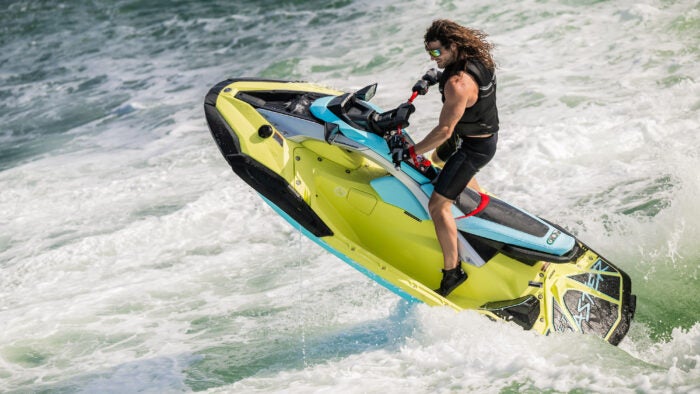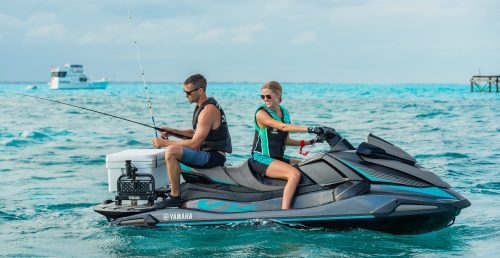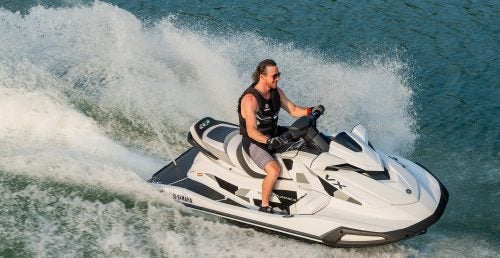2025 Yamaha JetBlaster PRO 2-Up Review

The JetBlaster is dead. Long live the JetBlaster!
FAST FACTS
Engine: Yamaha 1049cc TR-1 High Output
Fuel Capacity: 13.2 gal.
Stowage Capacity: 1.5 gal.
Seating Capacity: 2
MSRP: Starting at $11,199
Like the age-old proclamation about the king, it’s a statement that is simultaneously truthful and contradictory. Yamaha’s playful JetBlaster, introduced in just 2022, is already history as of the 2025 model year. The JetBlaster name, however, lives on in an all-new series of Rec-Lite models that replace the former EX line. They’re smaller, more playful and feature a bold new construction choice for Yamaha. If all goes to plan, they’ll entice a new, younger generation to, in Yamaha’s words, “enjoy the WaveRunner Lifestyle.”
Like the former king, one of these models – the JetBlaster PRO – continues to target freestyle types. In the process it also takes aim at, as well as a few tricks from, a familiar competitor.
Double Vision
 It’s hard to begin any discussion of the new JetBlaster without acknowledging its resemblance to the Sea-Doo SPARK. The top deck is made of reinforced polypropylene, molded-in colors have a matte finish, and there’s even a cutout below the handlebars that adds plenty of style points. At 9’ 9” in length, 3’ 9” in width and weighing as little as 575 pounds, JetBlasters are, like the SPARK, shorter and lighter than the typical PWC. Maintenance access is also limited to ports for key items like fuel tank, battery, fuses, oil and spark plugs. The ‘Blaster PRO also continues what the 2022-2024 models started by adding the SPARK TRIXX’s familiar trio of wider/taller handlebars for leverage, extended trim range to raise the bow and footwell chocks for added traction.
It’s hard to begin any discussion of the new JetBlaster without acknowledging its resemblance to the Sea-Doo SPARK. The top deck is made of reinforced polypropylene, molded-in colors have a matte finish, and there’s even a cutout below the handlebars that adds plenty of style points. At 9’ 9” in length, 3’ 9” in width and weighing as little as 575 pounds, JetBlasters are, like the SPARK, shorter and lighter than the typical PWC. Maintenance access is also limited to ports for key items like fuel tank, battery, fuses, oil and spark plugs. The ‘Blaster PRO also continues what the 2022-2024 models started by adding the SPARK TRIXX’s familiar trio of wider/taller handlebars for leverage, extended trim range to raise the bow and footwell chocks for added traction.
Why follow Sea-Doo’s lead? Yamaha reps pretty much admit many younger generation consumers passed over the relatively conservative EX in in favor of the fun, colorful and affordable SPARK. They also note they couldn’t produce the sharper angles and overall style they longed to achieve on the craft’s top deck using their SMC (fiberglass) presses. Polypropylene opened up new possibilities while reducing cost and allowing for both molded-in color and easier maintenance.
And let’s face it, almost all the manufacturers have followed the lead of another at one time throughout PWC history, especially when it comes to more unique craft. The Sea-Doo LRV was reminiscent of Yamaha’s unique SUV four-seater, the Yamaha SuperJet another version of the iconic Kawasaki Jet Ski standup, the Sea-Doo HX a version of the Yamaha WaveBlaster, etc. I give massive kudos to Sea-Doo for proving the concept and being creative, but I also can’t fault Yamaha for following the market and giving the consumer what they want.
Unique Traits
Yamaha also follows their own path in many aspects. Most notably, the JetBlaster retains an SMC fiberglass hull. It’s got a nice, contrasting gloss but also offers the rigidity where hull meets water that polypropylene lacks. It’s immediately felt in rough chop. I expected to feel a familiar jolt when leaving the protection of Yamaha’s Boston Harbor test location. Instead the hull tracked straight and true while delivering a surprisingly soft ride. And while definitely playful, the newly designed hull also cornered with equally surprising precision when trimmed down. In fact, the JetBlaster loves to carve and it responds to input at the handlebars almost instantly. As the driver, you also feel that your body weight and positioning has a significant effect on the response, unlike the feeling of most of today’s larger models.
When trimmed up to its new max nozzle angle 25.5 degrees above horizontal, the new JetBlaster PRO also does something the old JetBlaster failed to achieve – the coveted wheelie. Taller, heavier riders will have an easier go of it, but within a few attempts even a 5’ 8”, 155-pound guy like me was able to pull the bow skyward and hold it. With a little lean and finesse I was even able to coax the hull into a tailspin and hold it until I was dizzy. Trimmed similarly you can also spin out the stern, hop the craft skyward and launch off waves and wakes. I’d love to be able to jump between favorite trim settings with a no-look “double tap” like on the SPARK, but the newly designed footwell chocks provide a firm footing when the craft goes vertical, and the taller, wider handlebars (presented in a racier “naked” setup) help get your weight further back and provide more leverage over the craft than the standard JetBlaster package.
Other positives included the PRO’s comfy, two-tone EVA traction mats across the width of the aft platform as well as on the foot chocks; 4.3-inch color Connext display with Drive Control, trip details and engine lockout for security; spring-loaded stern boarding step; and RiDE throttle and reverse control which delivers intuitive low-speed handling as well as deceleration/stopping power when needed.
And then, of course, there’s the engine. Yamaha’s TR-1 is offered here in its 110hp variation, giving the JetBlaster an edge in low-end power and a 50 mph top-end speed. It’s fully accessed via a removable center section of the deck that allows the handlebars and controls to remain attached, meaning the engine can still be started with the center deck section removed (an advantage mostly for dealers during service). That engine is also paired to an all-new pump, with new transom plate, impeller for better acceleration, impeller housing, nozzle and deflector and trim ring.
Welcome To The Club
So yes, the JetBlaster PRO 2-UP is similar to the SPARK TRIXX 2-Up in many ways, and yet it retains its own unique personality in many others.
My takeaway? The SPARK TRIXX is looser and lighter, the JetBlaster PRO more solid feeling in rougher conditions and more precise in overall handling. The ‘Blaster offers better overall power, the TRIXX is a little easier for smaller riders to spin out or pull into a wheelie. Both are pretty lacking in storage, but the target audience likely won’t care. (For those that do, both have accessory storage options.) The Yamaha has greater fuel capacity. The Sea-Doo, in both one and three-passenger versions, is more affordable.
Ultimately, the JetBlaster Pro gives the SPARK TRIXX competition in the freestyle segment of the Rec-Lite class. And for us showoffs (er, freestyle-oriented consumers) that’s all we needed to hear.
Get PersonalWatercraft.com in your Inbox!
Like PersonalWatercraft.com on Facebook
Comments
Most Popular

2025 Yamaha JetBlaster PRO 2-Up Review

Remembering the Sea-Doo XP

2024 Kawasaki Jet Ski STX 160X Review

Whatever Happened to the Wetbike?

2025 Yamaha JetBlaster Review



















 Your Privacy Choices
Your Privacy Choices